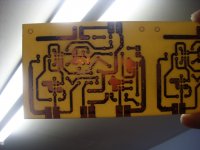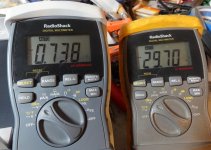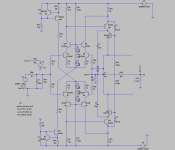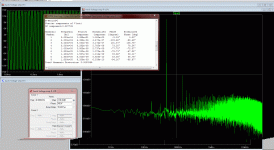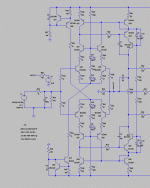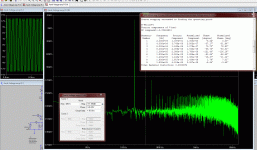Amp fall in to oscillationsAfter blowing fuses on my Super A ...


Actually, what I always claim is that there is not a lot of difference in the way they sound when pitted against each other with the volume is equalized. I must say I was quite surprised how much difference I saw yesterday when I played that 100k square waves through them. No two were alike and some looked dreadful. I'm still not sure how much the way an amp plays a 100k square wave affects what we hear. After blowing fuses on my Super A, I'm not sure how anxious I am to continue the practice. Seems it's hard on the components.
On this new CFA, I changed the input filter to the 560R/100p and there is only a very slight change. I wonder if that big 10uf film cap is affecting it. I will try jumping it today and see if that changes things. I'm not in love with the way this amp sounds. There is still a little too much upper mids. The snare doesn't sit nice in the mix and vocal affects are emphasized. We'll see if bypassing the input cap will improve things. Looking forward to building some more IPS's.
Blessings, Terry
It is real easy to jump onto the toner transfer "train".
-one cheap HP printer (I have a HP P1005 - 100$)
-glossy magazine pages
-cheap iron on highest heat setting.
As many IPS's as you can print/imagine.
I got it near perfect years ago .... (link) - http://www.diyaudio.com/forums/solid-state/169590-mongrel-supersym-ii-26.html#post2438681
Those were the first "badgers" , but with a modular scheme. 😎
OS
Attachments
Terry, use the smallest square wave that you can. If too large, it will just jam the transistors on and off, and this never happens with music signals. A small square wave will give you the step response that is actually applicable to what you hear. This step response depends on compensation, transistor parasitics, loading and often rail impedance.
For thimios ...
I looked ... post #599 is the SOTA (best) wolverine PCB.
The Wolverine is the only one with a CCS VAS .. and the only one
that "flirts" with 1-2ppm over most of the audio spectrum.
You can also see what the "Honey badger" sounds like 😎 .
OS
I looked ... post #599 is the SOTA (best) wolverine PCB.
The Wolverine is the only one with a CCS VAS .. and the only one
that "flirts" with 1-2ppm over most of the audio spectrum.
You can also see what the "Honey badger" sounds like 😎 .
OS
It is real easy to jump onto the toner transfer "train".
-one cheap HP printer (I have a HP P1005 - 100$)
-glossy magazine pages
-cheap iron on highest heat setting.
As many IPS's as you can print/imagine.
I got it near perfect years ago .... (link) - The MONGREL (supersym II)
Those were the first "badgers" , but with a modular scheme.
I actually have all the stuff to etch. Even a fancy tank with heater and aerator. My problem is that my laser jet is a Brother and just doesn't work for toner transfer. Been too cheap to buy an HP. I can have these small PCB's made for less than $5 each and Photo sensitive PCB's cost $8 per. Add to that the factory made boards are two sided with vias, soldermask and screenprint, it just doesn't make sense to me to etch. The drawback of course is that I need an expert like Jason to create Gerbers. Thank God for Jason! 😀
Terry, use the smallest square wave that you can. If too large, it will just jam the transistors on and off, and this never happens with music signals. A small square wave will give you the step response that is actually applicable to what you hear. This step response depends on compensation, transistor parasitics, loading and often rail impedance.
What do you mean by small?
Terry, what is the output voltage when testing with 100kHz square waves.
Testing at low output levels should give a fair analysis ?, without blowing much,
but I keep my finger on my zobel resistor, just in case 😱.
I use a 5Vpk output level when testing square waves, Is this OK?
Regards
Edit, posted before I read above posts.
Testing at low output levels should give a fair analysis ?, without blowing much,
but I keep my finger on my zobel resistor, just in case 😱.
I use a 5Vpk output level when testing square waves, Is this OK?
Regards
Edit, posted before I read above posts.
I'm quite the novice so I can only report what I see. With a volt meter hooked up to the output and watching the scope, the higher I go in frequency, the less voltage I see on the output to get the same approximate level on the scope. What 40vac looks like at 1K takes about 1.5vac at 100k. Square wave seem to reveal more but there is a cost if not very carefully used.
I'm quite the novice ...
I'm quite a novice too, and took out one of the three pairs (2 transistors) in the amp I'm building.
I was chatting with a buddy while driving 100kHz sqaure wave into the amp, turning the level up into nearly clipping level.
So at the cost of a new MJL21194/MJL21193 and two fuses, not fun wasting money.
Regards
Terry i have a question for you.I'm quite the novice so I can only report what I see. With a volt meter hooked up to the output and watching the scope, the higher I go in frequency, the less voltage I see on the output to get the same approximate level on the scope. What 40vac looks like at 1K takes about 1.5vac at 100k. Square wave seem to reveal more but there is a cost if not very carefully used.
What type of voltmeter used for these output A.C measurements?
Thimios.
Terry i have a question for you.
What type of voltmeter used for these output A.C measurements?
Thimios.
Attachments
O-stripper- Gentlmen Here's one for you, A little Leach, a little folded cascode and a little bit of me. An innovative mirror and a HawksFord VAS.
Tremendous PSSR and some serious distortion cancellation.
Add your favorite OPS VBE and...
Maybe Stripper should form the compensation to fit his EF-triple
Tremendous PSSR and some serious distortion cancellation.
Add your favorite OPS VBE and...
Maybe Stripper should form the compensation to fit his EF-triple
Attachments
I can't see the type.
Are these true rms?
Are these specific for A.C MEASURMENTS 100khZ
Cheap digital voltmeters measure only sinusoidal and up to 400 hz
For square wave you need "true rms" ,these comes up to 1khz (usual).
If you want to measure high frequencies you need more expensive voltmetres.
Are these true rms?
Are these specific for A.C MEASURMENTS 100khZ
Cheap digital voltmeters measure only sinusoidal and up to 400 hz
For square wave you need "true rms" ,these comes up to 1khz (usual).
If you want to measure high frequencies you need more expensive voltmetres.
Last edited:
Thimios,
I think you are more than likely correct that these are not true rms ac meters. This is one reason that I have kept my B&K analog ac meter, though I need to rebuild it with new capacitors. I do have a digital ac meter that is supposed to be a true rms ac meter but not sure what frequency that they are good for?
I think you are more than likely correct that these are not true rms ac meters. This is one reason that I have kept my B&K analog ac meter, though I need to rebuild it with new capacitors. I do have a digital ac meter that is supposed to be a true rms ac meter but not sure what frequency that they are good for?
Hi Steve ,i have checked this many times.Thimios,
I think you are more than likely correct that these are not true rms ac meters. This is one reason that I have kept my B&K analog ac meter, though I need to rebuild it with new capacitors. I do have a digital ac meter that is supposed to be a true rms ac meter but not sure what frequency that they are good for?
Oh oh new IPS ....MY GOD!O-stripper- Gentlmen Here's one for you, A little Leach, a little folded cascode and a little bit of me. An innovative mirror and a HawksFord VAS.
Tremendous PSSR and some serious distortion cancellation.
Add your favorite OPS VBE and...
Maybe Stripper should form the compensation to fit his EF-triple

We need a pcb soonOhhh, Posted the one without the special mirror... This is better at higher voltages and higher frequencies.

- Home
- Amplifiers
- Solid State
- Slewmaster - CFA vs. VFA "Rumble"
